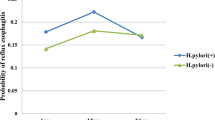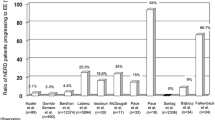Abstract
There is evidence that Helicobacter pylori eradication might predispose to gastroesophageal reflux disease (GERD). The aim of this prospective study was to examine the effectiveness of antisecretory treatment, after successful H. pylori eradication, in preventing GERD, since no data exist so far. Eighty initially H. pylori(+) patients, without GERD at the time of H. pylori eradication [50 peptic ulcer (PU) and 30 nonulcer (NU), 55 men, 25 women, median age 38 years, range 19–57], after successful H. pylori eradication were randomized to recieve either omeprazole 20 mg daily (group A) or no treatment (group B) for one year. All patients underwent upper gastrointestinal endoscopy at 0, 6, and 12 months or when GERD symptoms occurred. There were 40 patients in each group, and there were no statistically significant differences between the two groups in terms of sex, age, body weight, ulcer/no ulcer ratio, and other demographic data. Seven patients from group A and five patients from group B were lost to follow-up, and therefore there were 33 and 35 patients in groups A and B, respectively, who completed the study. One of 33 patients in group A (3%) and 10/35 (28.5%) in group B developed GERD symptoms during follow-up (P = 0.0022). The respective values for esophagitis were 0/33(0%) and 6/35(17.1%) (P = 0.0083). In conclusion, antisecretory treatment in H. pylori(+) patients, after successful eradication, is effective in preventing GERD.
Similar content being viewed by others
References
Marshall BJ, McGechie DB, Rogers PA, Glancy RJ: Pyloric Campylobacter infection and gastroduodenal disease. Med J Aust 142:439–444, 1985
Rokkas T, Sladen GE: Infection with Campylobacter pylori. J R Coll Physicians London 22:97–100, 1988
Graham D: Campylobacter pylori and peptic ulcer disease. Gastroenterology 96:615–625, 1989
Raws EA, Tytgat GNJ: Cure of duodenal ulcer associated with eradication of Helicobacter pylori. Lancet 335:1233–1235, 1990
Tytgat GNJ, Lee A, Graham DY, Dixon MF, Rokkas T: The role of infectious agents in peptic ulcer disease. Gastroenterol Int 6:76–89, 1993
Graham DY, Lew GM, Klein PD, Evans DG, Evans DJ Jr, Saeed ZA, Malaty HM: Effect of treatment of Helicobacter pylori infection and the long term reccurence of gastric and duodenal ulcer; a randomized, controlled study. Ann Intern Med 116:705–708, 1992
Sentander C, Gravalos RG, Codenilla AG, Pajares JM: Maintenance treatment versus Helicobacter pylori eradication therapy in preventing rebleeding of peptic ulcer disease. A clinical trial and follow up for two years. Gastroenterology 108:A208, 1995
Graham DY, Hepps KS, Ramirez FC, Lew GM, Saeed ZA: Treatment of Helicobacter pylori reduces the rate of rebleeding in peptic ulcer disease. Scand J Gastroenterol 28:939–942, 1993
Jaspersen D, Koerner T, Schorr W, Brennenstuhl M, Raschka C, Hammar CH: Helicobacter pylori eradication reduces the rate of rebleeding in ulcer haemorrhage. Gastrointest Endosc 41:5–7, 1995
Rokkas T, Karameris A, Mavrogeorgis A, Rallis E, Giannikos N: Eradication of Helicobacter pylori reduces the possibility of rebleeding in peptic ulcer disease. Gastrointest Endosc 41:1–4, 1995
Vicary JJ, Peek RM, Falk GW, Goldblum JR, Easley KA, Schnell J, Perez-Perez GI, Halter SA, Rice TW, Blaser MJ, Richter JE: The seroprevalence of cagA-positive Helicobacter pylori strains in the spectrum of gastroesophageal reflux disease. Gastroenterology 115:50–57, 1998
O'Connor HJ, Cunnane K: Helicobacter pylori and gastroesophageal reflux disease. Ir J Med Sci 163:369–373, 1994
Vicari JJ, Falk GW, Goldlum JR, Easley K: Helicobacter pylori is not a pathogenetic factor in GERD or its complications. Gastroenterology 112:A322, 1997
Newton M, Bryan R, Burnham WR, Kamm MA: Evaluation of Helicobacter pylori in reflux oesophagitis and Barrett's oesophagus. Gut 40:9–13, 1997
Varanasi RV, Fantry GT, Wilson KT: Decreased prevalence of H. pylori infection in Gastroesophageal reflux disease. Helicobacter 3:188–194, 1998
Labenz J, Blum AI, Bayerdorffer E, Meining A, Stolte M, Borsch G: Curing Helicobacter pylori infection in patients with duodenal ulcer may provoke reflux esophagitis. Gastroenterology 112:1442–1447, 1997
Dixon MF, Genta RM, Yardley JH, Correa P: Classification and grading of gastritis. The updated Sydney system. Am J Surg Pathol 20:1161–1181, 1996
Armstrong D, Bennett JR, Blum AL, Dent J, De Dombal FT, Galmiche J-P, Lungell L, Margulies M, Richter JE, Spechler SJ, Tytgat GNJ, Wallin L: The endoscopic assessment of of esophagitis: A progress report on observer agreement. Gastroenterology 111:85–92, 1996
Motalsky H: Intuitive Biostatistics. New York, Oxford University Press, 1995
Locke GR, Talley NJ, Fett SL, Zinsmeister AR, Melton LJ: Prevalence and clinical spectrum of gastroesophageal reflux disease: A population-based study in Olmsted County, Minnesota. Gastroenterology 112:1448–1456, 1997
Collen MJ, Lewis JH, Benjamin SB: Gastric acid secretion in refractory gastroesophageal reflux disease. Gastroenterology 98:654–661, 1990
Miller LS, Vinayek R, Frucht H, Gardner JD, Jensen RT, Maton PN: Reflux esophagitis in patients with Zollinger-Ellison syndrome. Gastroenterology 98:341–346, 1990
Chow WH, Blaser MJ, Blot WJ, Gammon MD, Vaughan TL, Risch HA, Perez-Perez GI, Schoenberg JB, Stanford JL, Rottedam H, West AB, Fraumeni JF Jr: An inverse relation between cagA1 strains of Helicobacterr pylori infection and risk of esophageal and gastric cardia adenocarcinoma. Cancer Res 58:588–590, 1998
Loof L, Gotell P, Elfberg B: The incidence of reflux esophagitis. A study on endoscopy report from a defined catchment area in Sweden. Scand J Gastroenterol 28:113–118, 1993
Petersen H: The prevalence of gastro-esophageal reflux disease. Scand J Gastroenterol 30(suppl 211):5–6, 1995
Goggin PM, Marrero JM, Ahmed H, Jackson PA, Corbishley CM, Northfield TC: Urea hydrolysis in Helicobacter pylori infection. Eur J Gastroenterol Hepatol 3:927–933, 1991
Bersik P, Verdu EF, Armstrong D, Cederberg C, Idstrom J-P, Stolte M, Blum AL: H. pylori related increase in omeprazole (OME) effect is associated with ammonia production. Gastroentereology 110:A64, 1996
Verdu EF, Bercik, P, Armstrong D, Sobovcikova L, Idström J-P, Caderberg C, Blum AL: Production of volatile amines by Helicobacter pylori (Hp) is not relevant in vivo. Gastroenterology 110:A285, 1996
Galmiche JP, Janssens J: The pathophysiology of gastrooesophageal reflux disease: An overview. Scand J Gastroenterol 30(suppl 211):7–18, 1995
Konturek SJ, Konturek PJ, Brzozowski T, Stachnura J, Zombala M: Gastric mucosal damage and adaptive protection by ammonia and ammonium ions in rats. Dig Dis Sci 57:433–445, 1996
El-Omar EM, Penman ID, Ardill JE, Chittajallu RS, Howie C, McColl KE: Helicobacter pylori infection and abnormalities of acid secretion in patients with duodenal ulcer disease. Gastroenterology 109:681–691, 1995
El-Omar EM, Penman ID, Dorrian CA, Ardill JE, McColl KE: Eradication of Helicobacter pylori infection lowers gastrin mediated acid secretion by two thirds in patients with duodenal ulcer. Gut 34:1060–1065, 1993
Harris AW, Gummett PA, Misiewicz JJ, Baron JH: Eradication of Helicobacter pylori in patients with duodenal ulcer lowers basal and peak acid outputs to gastrin releasing peptide and pentagastrin. Gut 38:663–667, 1996
Gisbert JP, Boixela D, Vila T, de Rafael L, Redondo C, de Argila CM: Basal and stimulated gastrin levels and gastric acid output five months after therapy for Helicobacter pylori eradication in duodenal ulcer patients. J Clin Gastroenterol 22: 90–95, 1996
El-Omar EM, Oien K, El-Nujumi A, Gillen D, Wirz A, Dahill S, Williams C, Ardill JE, McColl KE: Helicobacter pylori infection and chronic gastric acid hypersecretion. Gastroenteerology 113:15–24, 1997
Haruma K, Mihara M, Okamoto E, Kusunoki H, Hananoki M, Tanaka S, Yoshihara M, Sumii K, Kajiyama G: Eradication of Helicobacter pylori increases gastric acidity in patients with atrophic gastritis of the corpus-evaluation of 24–h pH monitoring. Aliment Pharmacol Ther 13:155–162, 1999
Beil W, Birkholz C, Wagner S, Sewing K-F: Interaction of Helicobacter pylori and its fatty acids with parietal cells and gastric H+/K+-ATPase. Gut 25:1176–1180, 1994
Cave DR, Vargas M: Effect of a Campylobacter pylori protein on acid secretion by parietal cells. Lancet 2:187–189, 1989
Feldman M, Cryer B, McArthur KE, Lee E: Relationship between severity of H. pylori (HP) gastritis and gastric acidpepsin secretion in man. Gastroenterology 110:A106, 1996
Yasunaga Y, Shinimura Y, Kanayama S, Yabu M, Nakanishi T, Miyazaki Y, Murayama Y, Bonilla-Palasios JJ, Matsuzawa Y: Improved fold width and increased acid secretion after eradication of the organism in Helicobacter pylori associated enlarged fold gastritis. Gut 35:1571–1574, 1994
Esplugues JV, Barrachina MD, Calatayud S, Pique JM, Whittle BJ: Nitric oxide mediates the inhibition by interleukin-1 beta of pentagastrin-stimulated rat gastric acid secretion. Br J Pharmacol 108:9–10, 1993
McGowan CC, Cover TL, Blaser MJ: Helicobacter pylori and gastric acid: Biological and therapeutic implications. Gastroenterology 110:926–938, 1996
Pfeiffer A, Krömer W, Friemann J, Ruge M, Herawi M, Schätzl M, et al: Muscarinic receptors in gastric mucosa are increased in peptic ulcer disease. Gut 36:813–818, 1995
Robert A, Olafsson AS, Lancaster C, Zhang WR: Interleukin-1 is cytoprotective, antisecretory, stimulates PGE2 synthesis by the stomach, and retards gastric emptying. Life Sci 48:123–134, 1991
Takeuchi K, Ohuchi T, Okabe S: Effects of nitric oxide synthase inhibitor N g-nitro-L-arginine methyl ester on duodenal alkaline secretory and ulcerogenic responses induced by mepirizole in rats. Dig Dis Sci 40:670–677, 1995
Rokkas T, Liatsos C, Karameris A, Petridou E, Papatheodorou G, Kalafatis E: Serologic detection of CagA Helicobacter pylori strains predicts the presence ofpeprtic ulcer in young dyspeptic patients. Gastrointest Endosc 50:511–516, 1999
Yamaoka Y, Kita M, Kodama T, Sawai N, Kashima K, Imanishi J: Induction of various cytokines and development of severe mucosal inflammation by cagA gene positive Helicobacter pylori strains. Gut 41:442–451, 1997
El-Serag HB, Sonnenberg A: Opposing time trends of peptic ulcer and reflux disease. Gut 43:327–333, 1998
Author information
Authors and Affiliations
Rights and permissions
About this article
Cite this article
Rokkas, T., Ladas, S., Liatsos, C. et al. Effectiveness of Acid Suppression in Preventing Gastroesophageal Reflux Disease (GERD) After Successful Treatment of Helicobacter pylori Infection. Dig Dis Sci 46, 1567–1572 (2001). https://doi.org/10.1023/A:1010616710501
Issue Date:
DOI: https://doi.org/10.1023/A:1010616710501




